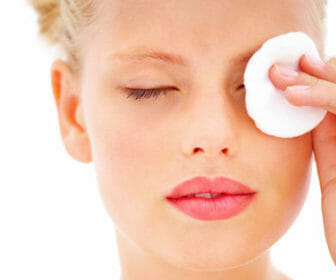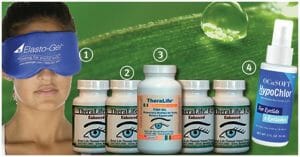Crusty eyes are the chronic inflammation of the eyelids.
The most common eye disease known is Blepharitis. Blepharitis leaves sufferers with eyes and eyelids that itch, burn, and are red. Many times, the eyelids stick together in the morning from a crust that forms during the night.
The edge of the eyelid and inner lining of the eye are both affected by crusty buildup. The transparent outer layer of the eye and the skin of the eyelid is also be affected.
Adults seem to suffer from Blepharitis more than children. Certain families seem to develop this condition, and children with Down’s syndrome. Luckily, there is no relief for those who suffer from crusty eyes from TheraLife.
Best Crusty Eyes Treatment – TheraLife All-In-One Starter Kit
TheraLife has created a complete kit to help those who suffer from Blepharitis. The TheraLife Starter Kit contains:
- Four bottles of TheraLife Eye capsules
- One bottle of molecularly distilled purified Fish Oil
- One bottle of Avenova eyelid cleanser
- One hot gel compress
Everything needed to relieve crusty eyes. As with all TheraLife products, there is a 90-day money-back guarantee.
Don’t continue to suffer from red, itchy, irritated eyes. Order your TheraLife All-In-One Starter Kit and help your eyes find relief and stay healthy.
To learn more- visit theralife.com.
Questions? Call toll free 1-877-917-1989 US/Canada.
International (650) 949-6080
Customer Success Story
Crusty Eyes, Blepharitis MGD Recovery
I have had blepharitis/MGD that would come be crusty and concurrent with a pink eye for quite a few years, but it has always gone away pretty quickly on its own. However, this last time, blepharitis and dry eye did not leave, and it became pretty disruptive to my life. My eye doctor gave me eye drops, making my eyes feel drier. I felt as though I had no hope for my eyes, and they were going to keep getting worse and worse. Despite being reasonably skeptical, I finally decided to try Theralife, and I’m So glad I did. I’ve now been taking it for just over two weeks, and I already feel so much better. This morning I woke up, and my eyes were almost white instead of bright red. My blurry vision cleared up, the stickiness gone from my eyes, and the stinging had virtually gone.
I’m looking forward to them getting better and better. Thanks so much!”
Cindy, USA
_______________________________
Other Testimonials
Types of Crusty Eyes
It is crucial to know the structure of the eyelid. There are two layers of the eyelid. These two layers can be independently affected by crusty eyes. Since each layer of the eyelid is unique, one or both of these layers may be affected.
Anterior Blepharitis:
The front part of the eyelid can develop a burning, itching, or irritation. The cause of this type of pain is most often due to a bacterial infection or a chronic inflammatory skin condition known as seborrheic dermatitis.
When this happens, the anterior or front part of the eyelid is diagnosed with anterior Blepharitis.
Posterior Blepharitis:
Posterior Blepharitis is inflammation of the inner layer of the eyelid that becomes inflamed. The inside layer of the eyelid contains small glands (Meibomian Glands) that secrete oils that protect the eye from dirt and debris.
However, when meibomian glands become irritated from a bacterial infection, the production of excess oils can cause the eyes to feel like they are burning. The eyelids may also appear red and swollen. Bacteria can plug the meibomian glands at the edges of the eyelid.
Seborrheic dermatitis:
Seborrheic dermatitis is the inflammation of the skin, where the scalp, eyebrows, and eyelids are affected. Two-thirds of people who suffer from anterior Blepharitis also suffer from seborrheic dermatitis.
Seborrheic dermatitis results in skin that secrete oil, swollen eyelids, the skin to scale and flake, and the itching and burning of the eyes. One or both eyelid layers can be affected.
Formation of styes
An abscess in the hair follicles or sweat glands of the eyelid is called a stye. A stye occurs in one out of three people with Blepharitis. A stye forms quickly and can be painful. Warm compresses often help soothe these painful areas.
Often following the formation of a style (which is infectious), or a chalazion is a hard nodule from oils trapped in a blocked gland of the eyelid.
Unlike a stye, a chalazion usually is not painful. A chalazion forms after Blepharitis occurs in the anterior or posterior eyelid. Many patients who have chronic Blepharitis continually develop recurring chalazia.
To stop this recurring chalazion, treat Blepharitis, where dry eyes often cause the root cause. Keeping the meibomian glands of the eyelid free from clogging will prevent chalazion.
Treatment Options for Crusty Eyes
To prevent crusty eyes – keeping the eyelids clean and the meibomian glands free from blockage is critical.
Crust and sticky secretions can quickly lead to infection, burning, and redness.
A hot compress – not a warm washcloth, applied to the eyelid can help to remove some of the sticky secretions. Cleaning the eyelids right after a hot compress several times a day can help.
However, bacteria and mites which anchor onto the eyelashes tend to recur, causing this cycle of re-infection.
TheraLife highly recommends Avenova eyelid cleanser – which builds up a biofilm that blocks bacteria from re-attaching.
In severe cases, eye doctors prescribe antibiotics.
The crusty eye is difficult to treat, and prevention is preferred. But it requires special attention from the patient.
TheraLife has a solution to help those suffering from Blepharitis:
- Eye Lid Cleanser – TheraLife highly recommends Avenova eyelid cleanser that helps to clean the eyelid and stops the reattachment of bacteria and mites that cause inflammation. It is gentle and effective.
- Hot Compress – Clean eyelids thoroughly and then apply a hot gel compress to un-clogged meibomian oil glands. A steady flow of oil to the eye not only soothes red, irritated eyes but keeps bacteria from forming. A hot washcloth is not good enough. Heat a gel or bean baggy in the microwave oven is the preferred solution.
- TheraLife Eye Capsules – TheraLife has created a line of oral capsules to help the cells of the eyes restore balance/functions, reduce inflammation, and sustain tears all day long.
References
- Saccà SC, Pascotto A, Venturino GM, et al. Prevalence and treatment of Helicobacter pylori in patients with blepharitis. Invest Ophthalmol Vis Sci. 2006;47:501-508.
- Bernardes TF, Bonfioli AA. Blepharitis. Semin Ophthalmol. 2010;25:79-83.
- Lemp MA, Nichols KK. Blepharitis in the United States 2009: a survey-based perspective on prevalence and treatment. The Ocular Surface. 2009;7(suppl):1-24.
- Dougherty JM, McCulley JP. Comparative bacteriology of chronic blepharitis. Br J Ophthalmol. 1984;68:524-528.
- Groden LR, Murphy B, Rodnite J, Genvert GI. Lid flora in blepharitis. Cornea. 1991;10:50-53.
- Dougherty JM, McCulley JP. Bacterial lipases and chronic blepharitis. Invest Ophthalmol Vis Sci. 1986;27:486-491.
- McCulley JP, Shine WE. The lipid layer of tears: dependent on meibomian gland function. Exp Eye Res. 2004;78:361-365.
- Bron AJ, Sci FM, Tiffany JM. The contribution of meibomian disease to dry eye. Ocul Surf. 2004;2:149-165.
- McCulley JP, Shine WE. Meibomian secretions in chronic blepharitis. Adv Exp Med Biol. 1998;438:319-326.
- Seal DV, McGill JI, Jacobs P, Liakos GM, Goulding NJ. Microbial and immunological investigations of chronic nonulcerative blepharitis and meibomianitis. Br J Ophthalmol. 1985;69:604-611.
- Kheirkhah A, Casas V, Raju VK, Tseng SC. Corneal manifestations of ocular demodex infestation. Am J Ophthalmol. 2007;143:743-749.
- Liu J, Sheha H, Tseng SC. Pathogenic role of Demodex mites in blepharitis. Curr Opin Allergy Clin Immunol. 2010;10:505-510.
- Wojtowicz JC, Butovich I, Uchiyama E, et al. Pilot, prospective, randomized, double-masked, placebo-controlled clinical trial of an omega-3 supplement for dry eye. Cornea. 2011;30:308-314.
- Pinheiro MN Jr, dos Santos PM, dos Santos RC, Barros Jde N, Passos LF, Cardoso Neto J. Oral flaxseed oil (Linum usitatissimum) in the treatment for dry-eye Sjögren’s syndrome patients [in Portuguese]. Arq Bras Oftalmol. 2007;70:649-655.
- Larmo PS, Järvinen RL, Setälä NL, et al. Oral sea buckthorn oil attenuates tear film osmolarity and symptoms in individuals with dry eye. J Nutr. 2010;140:1462-1468.
- Macsai MS. The role of omega-3 dietary supplementation in blepharitis and meibomian gland dysfunction (an AOS thesis). Trans Am Ophthalmol Soc. 2008;106:336-356.
- Filho PA, Hazarbassanov RM, Grisolia AB, Pazos HB, Kaiserman I, Gomes JÁ. The efficacy of oral ivermectin for the treatment of chronic blepharitis in patients tested positive for Demodex spp. Br J Ophthalmol. 2011;95:893-895.
- Holzchuh FG, Hida RY, Moscovici BK, et al. Clinical treatment of ocular Demodex folliculorum by systemic ivermectin. Am J Ophthalmol. 2011;151:1030-1034.
- Gao YY, Di Pascuale MA, Elizondo A, Tseng SC. Clinical treatment of ocular demodecosis by lid scrub with tea tree oil. Cornea. 2007;26:136-143.
- Gao YY, Di Pascuale MA, Li W, et al. In vitro and in vivo killing of ocular Demodex by tea tree oil. Br J Ophthalmol. 2005;89:1468-1473.
- Gao YY, Xu DL, Huang LJ, Wang R, Tseng SC. Treatment of ocular itching associated with ocular demodicosis by 5% tea tree oil ointment [published online ahead of print September 27, 2011]. Cornea.





